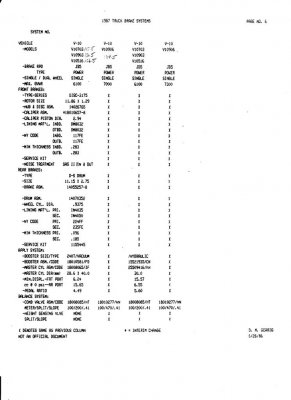Tranz Zam
Full Access Member
- Joined
- Jul 30, 2015
- Posts
- 131
- Reaction score
- 0
- Location
- MA
- First Name
- Ryan
- Truck Year
- 1973
- Truck Model
- K10
- Engine Size
- LM7 5.3
Hey guys,
I have a question about the two letter codes on the master cylinder and the brake booster. They're different codes, so they don't match up with each other. The truck stops, but it doesn't seem to bite very hard, and wont lock up the wheels.
The master is out of an 87 C10. I have no idea what the booster is out of. The original 87 C10 booster lost its pushrod, so I picked up a used booster with a pin. Initially I put the pin from the new booster into the 87 booster, but it looked like it stuck out too much, and hit the piston in the master cylinder before it was bolted flush to the booster, so I just swapped entire boosters.
The entire brake system on my truck is new, with the exception of the master, booster, and proportioning valve. Let me break down what I have on the truck:
New front calipers
New rear wheel cylinders
New pre bent steel lines
New rubber hoses for front and rear
I've bled the system 2 times now, and there's no air in the line that I can see.
I don't know if I'm just losing my mind here, or something is actually not matching up.
Any help is greatly appreciated guys, this is the last thing I need to figure out before I can drive the truck!
I have a question about the two letter codes on the master cylinder and the brake booster. They're different codes, so they don't match up with each other. The truck stops, but it doesn't seem to bite very hard, and wont lock up the wheels.
The master is out of an 87 C10. I have no idea what the booster is out of. The original 87 C10 booster lost its pushrod, so I picked up a used booster with a pin. Initially I put the pin from the new booster into the 87 booster, but it looked like it stuck out too much, and hit the piston in the master cylinder before it was bolted flush to the booster, so I just swapped entire boosters.
The entire brake system on my truck is new, with the exception of the master, booster, and proportioning valve. Let me break down what I have on the truck:
New front calipers
New rear wheel cylinders
New pre bent steel lines
New rubber hoses for front and rear
I've bled the system 2 times now, and there's no air in the line that I can see.
I don't know if I'm just losing my mind here, or something is actually not matching up.
Any help is greatly appreciated guys, this is the last thing I need to figure out before I can drive the truck!



